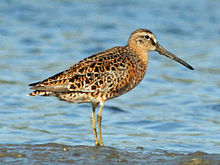Short-billed dowitcher
| Short-billed dowitcher | |
|---|---|

| |
| Scientific classification | |
| Domain: | Eukaryota |
| Kingdom: | Animalia |
| Phylum: | Chordata |
| Class: | Aves |
| Order: | Charadriiformes |
| Family: | Scolopacidae |
| Genus: | Limnodromus |
| Species: | L. griseus
|
| Binomial name | |
| Limnodromus griseus (Gmelin, JF, 1789)
| |

| |
Breeding Migration Nonbreeding
| |
| Synonyms | |
| |


The short-billed dowitcher (Limnodromus griseus), like its congener the
It is an inhabitant of
Taxonomy
The short-billed dowitcher was
Three subspecies are recognised:[12]
- L. g. caurinus Pitelka, 1950 – Breeds: Gulf of Alaska and inland central-south Alaska, southwest Yukon and montane northwest British Columbia (northwest Canada). Winters: central USA to Peru
- L. g. hendersoni Rowan, 1932 – Breeds: central-north Alberta to west Manitoba (central Canada). Winters: southeast USA to Panama
- L. g. griseus (Gmelin, JF, 1789) – Breeds: southwest Hudson Bay and James Bay to west Labrador (central-east Canada). Winters: south USA to Brazil
Description
The body of adults is dark brown on top and reddish underneath. The tail has a black and white barred pattern. The legs are a yellowish color.
The three subspecies have slight variations in appearance:
- L. g. griseus has a white belly and barred flanks.
- L. g. hendersoni has a reddish belly and spotted flanks.
- L. g. caurinus has a white belly with heavily barred flanks and densely spotted breast.
None of these combines the reddish belly and barred flanks of the breeding plumage long-billed dowitcher. The winter plumage is largely grey. This bird can range from 23 to 32 cm (9.1 to 12.6 in) in length, 46 to 56 cm (18 to 22 in) in wingspan and 73–155 g (2.6–5.5 oz) in body mass.[13]
The call of this bird is more mellow than that of the long-billed dowitcher, and is useful in identification, particularly of the difficult adult plumages.
Distribution and habitat
The breeding habitat of the short-billed dowitcher includes
The birds migrate to the southern United States and as far south as Brazil. This bird is more likely to be seen near ocean coasts during migration than the long-billed dowitcher. This species occurs in western Europe only as an extremely rare vagrant.
Behavior and ecology
Breeding
These birds nest on the ground, usually near water. Their nests are shallow depressions in clumps of grass or moss, which are lined with fine grasses, twigs and leaves. They lay four, sometimes three, olive-buff to brown
The downy juvenile birds leave the nest soon after hatching. Parental roles are not well known, but it is believed the female departs and leaves the male to tend the chicks, which find all their own food.
Food and feeding
These birds forage by probing in shallow water or on wet mud. They mainly eat
References
- . Retrieved 12 November 2021.
- ^ American Ornithologist' Union. Check-list of North American Birds. American Ornithologists' Union. 1998.
- ISBN 0-679-45122-6.
- ^ ISBN 978-0295977065.
- ^ ISBN 978-0547248325.
- ^ Gmelin, Johann Friedrich (1789). Systema naturae per regna tria naturae : secundum classes, ordines, genera, species, cum characteribus, differentiis, synonymis, locis (in Latin). Vol. 1, Part 2 (13th ed.). Lipsiae [Leipzig]: Georg. Emanuel. Beer. p. 658.
- ^ Latham, John (1785). A General Synopsis of Birds. Vol. 3, Part 1. London: Printed for Leigh and Sotheby. p. 154.
- ^ Pennant, Thomas (1785). Arctic Zoology. Vol. 2. London, United Kingdom: Printed by Henry Hughs. pp. 464–465.
- ^ Wied-Neuwied, Maximilian (1832). Beiträge zur Naturgeschichte von Brasilien (in German). Vol. 4. Weimar: Im Verlage des Landes-Industrie-Comptoirs. p. 716.
- ISBN 978-1-4081-2501-4.
- ^ "Dowitcher". Oxford English Dictionary (Online ed.). Oxford University Press. (Subscription or participating institution membership required.)
- Rasmussen, Pamela, eds. (August 2022). "Sandpipers, snipes, coursers". IOC World Bird List Version 12.2. International Ornithologists' Union. Retrieved 6 November 2022.
- ISBN 978-0-8493-4258-5.
External links
- Short-billed Dowitcher - Limnodromus griseus - USGS Patuxent Bird Identification InfoCenter
- Short-billed dowitcher species account - Cornell Lab of Ornithology
- "Short-billed dowitcher media". Internet Bird Collection.
- Short-billed dowitcher, Cape Jourimain Nature Centre
- Short-billed dowitcher photo gallery at VIREO (Drexel University)
- Interactive range map of Limnodromus griseus at IUCN Red List maps
- Audio recordings of Short-billed dowitcher on Xeno-canto.

